ISSN ONLINE(2319-8753)PRINT(2347-6710)
ISSN ONLINE(2319-8753)PRINT(2347-6710)
S. Sunil Kumar Reddy1 , Dr.V. Pandurangadu2
|
| Related article at Pubmed, Scholar Google |
Visit for more related articles at International Journal of Innovative Research in Science, Engineering and Technology
With the depletion and pollution of diesel fuels, researchers are concentrating much for the development of renewable alternative fuels for the existing diesel engines. Among all alcohols are found to be best because they are produced from sugarcane and are renewable in nature. But due to the properties of alcohol fuel, it is difficult to blaze them in the existing diesel engines. So, an insulated engine is developed with the insulation of the important engine components, which reduces the ignition delays and improves the thermal efficiency. In the present work experiments are conducted with brass piston insert with maximum number of grooves on the piston which generates higher temperatures in the combustion chamber. This plunge the volumetric efficiency and more increases the frictional horse power owing to thinning of lubricants. Therefore this drop is compensated by turbocharging. Further in order to withstand for higher temperatures in the engine, new lubricants are developed. These lubricants are blended with different percentages of Teflon based additives (TBA) and analyzed the frictional losses to find the best performed oil. Tests are conducted on a single cylinder 4-stroke, water-cooled 3.68 KW Kirloskar diesel engine with 165 bar fuel injection pressure with alcohol as a fuel.
Keywords |
| Alcohol, Insulated engine, PSZ, Turbocharger, Lubricants |
INTRODUCTION |
| In most of the diesel engines maximum amount of heat is lost to the cooling medium. With the less heat in the combustion chamber the alcohols will not burn due to its properties. So an insulated diesel engine (IE) is developed in the present work which operates at higher temperatures and pressures which further improves the fuel economy, reduced emissions and noise due to lower rate of pressure rise. Kamo and Nagesh [2] used partially stabilized Zirconium (PSZ) as the insulating material and reported that the emission levels are drastically reduced with the premixed combustion. Miyari et. Al [9] reported that there is 7% improvement in fuel consumption and reduction in the emissions. Wallace et. al[7] developed the temperature distribution analysis and reported that the temperature on the piston is increased by 4000C with the use of a thermal barrier piston in the adiabatic engine .From the experiments it is observed that much amount of heat will lost through the piston. So in order to retain the heat in the insulted combustion chamber various piston materials like Nimonic alloy, Copper and Brass are tried and concluded that brass piston insert will give maximum efficiency [7,11]. However, one of the main problems in the insulated engines is the drop in volumetric efficiency. This decrease in the volumetric efficiency is attributed to the decrease in the density of air entering the cylinder because of high wall temperatures of the insulated engine. J.Cheong et al (8) conducted experiments on high speed direct Injection (HSDI) diesel engine and concluded that air mass is increased by 10-20% low speed range. With that smoke was reduced and fuel consumption was improved with the same fuel delivery and injection pressure. Rakopoulos et al (10) developed a computer analysis for the study of performance of turbocharging diesel engine, operating under transient load conditions and it is validated with experimental results. Naser et al (12) concluded that with the increase of intake pressure the performance gains will be reduced due to decrease in density and this can be compensated with intercooler. He developed a MAT LAB program to find the effect of intercooler on a multi-cylinder engine for operation at constant speed of 1600 rpm. According to Wang et al [1] and Behrooz et al [4] engine failure occur with lubricant performance degradation and this further depends on the temperatures in the combustion chambers. With the problems of lubrication in the insulated engine Johnson et al [3] and Ruthmansdofer [5] and Gaydos et al [6] tried with several materials by coating piston rings, liners etc and they suggested a special lubricant made of synthetic oil which can withstand for higher temperatures. |
II DIFFERENT PHASES OF THE EXPERIMENT |
| The main objective of this investigation is to experimentally determine effect of Teflon based additive (TBA) on a newly developed lubricants in a turbocharged insulted diesel engine with alcohol as fuel at a reduced fuel injection pressure of 165 bar. The total experiment consists of the following phases |
| (i) Development of Insulated engine components |
| (ii) Experimental details with brass piston with grooves |
| (iii) Investigations with turbocharger to find the best boost up pressure |
| (iv) Development of new lubricants |
| (v) Testing of the engine with new lubricants |
| A. Development Of Insulated Engine Components |
| For the insulation of the engine components partially stabilized Zirconium (PSZ) is used which can withstand for higher temperatures. The thickness of the insulation was based on the theoretical analysis and recommendations made by Wong et al [13]. The insulation methodology is explained in detail as follows. 1. Air Gap Insulated Piston As the thermal conductivity of the air low, it is used 2 mm air-gap between the aluminum piston crown and skirt. The optimization of air gap is based on the previous literature available. The piston crown and skirt were separated by copper and steel gaskets. Figure.1 shows the air gap insulated aluminum piston. |
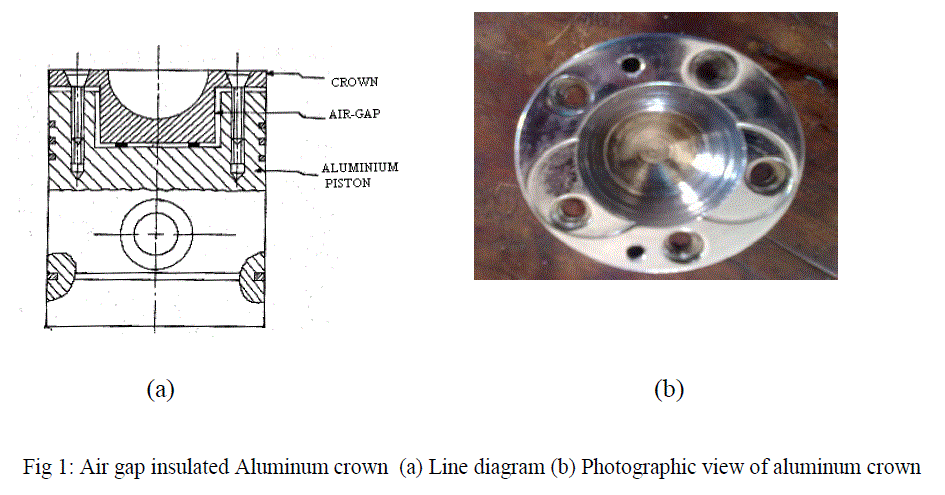 |
| 2. Insulated Cylinder Liner As the piston is moving inside the cylinder liner, it is not possible to insulate the liner from inner side. So it is insulated on the outer side. A thin mild steel sleeve is circumscribed over the liner with 2 mm air gap between the liner and the sleeve. In order to avoid the leakage of coolant water in to the air gap region, the joints of the sleeve are sealed. 3. Insulated Cylinder Head and valves The cylinder head combustion chamber area and the bottom surfaces of the two valves are machined to a depth of 0.5 mm and are coated with Partially Stabilized Zirconium (PSZ) material for the same depth. The Photographic views of cylinder head and valves are as shown in the Fig. 2. |
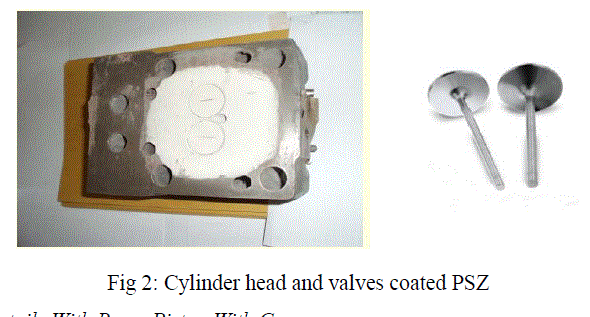 |
| B. Experimental Details With Brass Piston With Grooves For the experimentation a 3.68 kW Kirloskar DI diesel engine is used with alcohol as fuel. With the alcohols lower viscosity, higher self ignition temperature and higher latent heat of vaporization, the engine is operated at 165 bar fuel injection pressure and 270 bTDC with the rated speed of 1500 rpm. The concentrations of smoke and exhaust gases are measured with Bosch smoke meter and exhaust gas analyzer (Delta 1600S) respectively. |
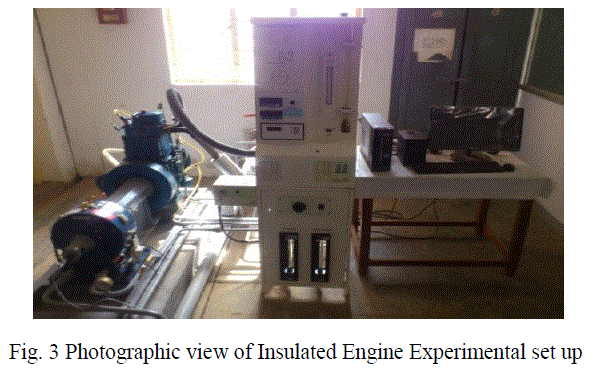 |
| For the burning of alcohols in the insulated engine more heat is to be retained in the combustion chamber, so that it can be given to the incoming fresh charge. Further the efficiency can be improved with turbulence in the combustion chamber. So in the present experimental work a brass crown piston with nine number of grooves (BP9) is designed for the experimentation and is compared with brass crown piston (BP). The size of the grooves is selected in such a way that maximum number of grooves can be generated on the piston crown. This brass crown is further knurled to increase its surface area thus facilitating better heat transfer rate from the hot gases to the crown. The photographic views of the two pistons used in the experimentation are shown in the following Fig. 4 & 5. |
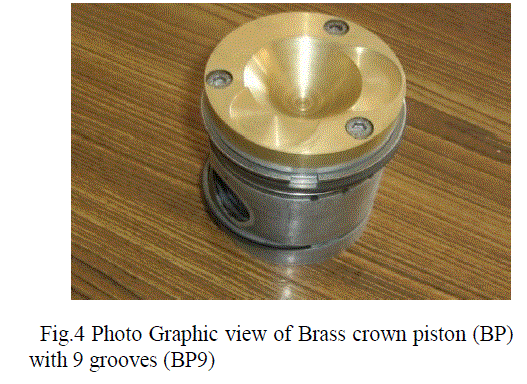 |
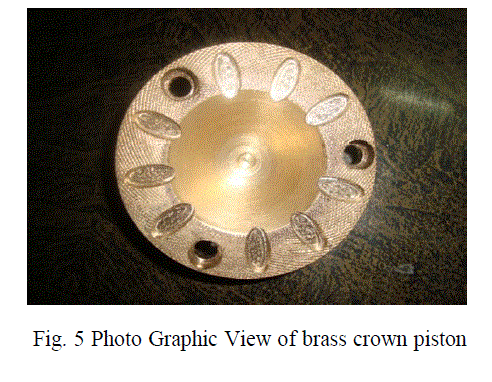 |
| 1. Investigative results of Brass piston with grooves in an Insulated Engine The experiments are performed with plain brass piston and brass piston with nine number of grooves in an insulated engine and is compared with aluminum piston in normal engine to find the best one in terms of brake thermal efficiency. But with the higher temperatures in the combustion chamber the volumetric efficiency is dropped and the results are presented below. The change in the volumetric efficiency with different configurations of the brass piston depicts in Exhibit 1. With the higher a temperature in the combustion chamber, the mass of air drawn is reduced which results in drop of volumetric efficiency. For BP9 the temperature generated in the combustion chamber due to turbulence is higher and further the drop in volumetric efficiency is about 1.2% as compared to BP and about 9.5% compared to normal engine at rated load. With the higher temperatures, the fuel in the combustion chamber will burn completely which results higher brake thermal efficiency. The brake thermal efficiency with BP9 is more than plain Brass piston and is evident from the Exhibit 2. So the drop in volumetric efficiency of an insulated engine can be compensated by turbocharging. Further the investigations are carried out with brass piston with nine grooves with turbocharged insulated engine. |
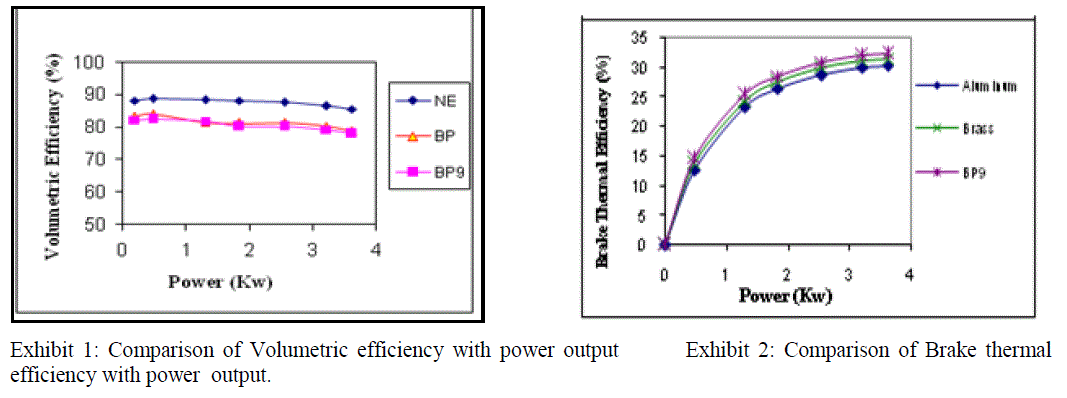 |
| C. Investigative Results Of Bp9 With Turbocharger The turbocharger squeezes more air into the engine cylinder to obtain more power. This further improves the power to weight ratio of the engine. The turbocharger uses exhaust to spin the turbine which further supplied to the compressor to compress the inlet air [7, 9]. Thus by controlling the amount air flowing in to the engine with a valve, the engine is turbocharged at different inlet pressures. The line diagram of the experimental set up is shown in the Fig. 6. The results of the insulated engine with turbocharging are given below. |
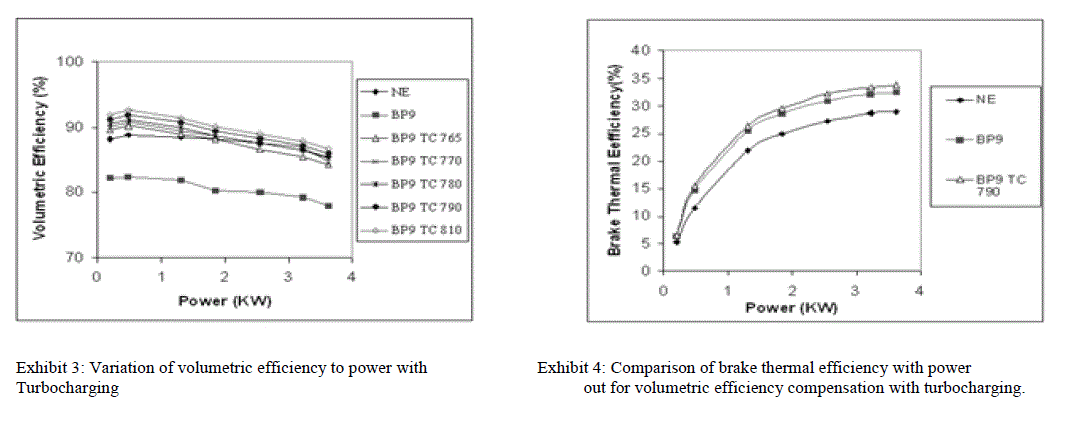 |
| 1. Effect of Turbocharging on the Volumetric Efficiency The exhibit 3 depicts the variation of volumetric efficiency with intake boost pressure. With the raise of intake boost up pressure the combustion is complete and improves the Efficiency but it doesn’t improve further with higher pressures. From the graph it is concluded that the optimum boost up pressure is 790 mm of Hg at which the call in the volumetric efficiency is compensated. |
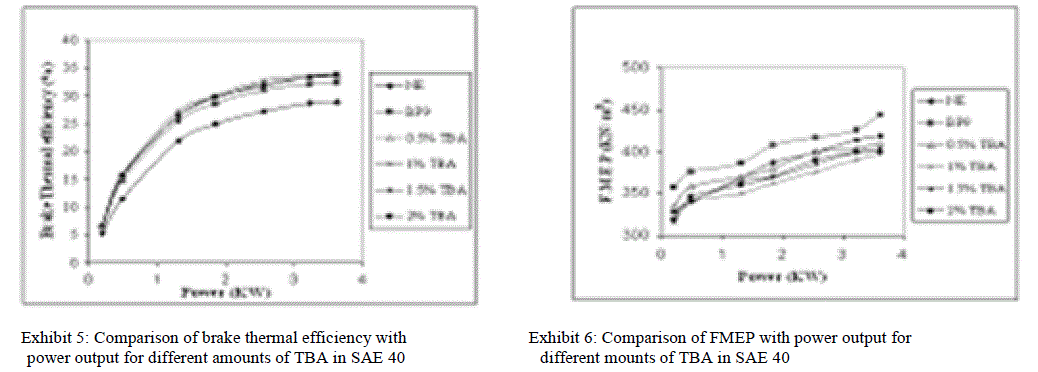 |
| 2. Effect of Turbocharging on the Brake Thermal Efficiency Exhibit 4 shown above illustrates the deviation of thermal efficiency with power output and is concluded that the improvement with BP9 is 4.3% compared to the insulated engine without turbocharger at 790 mm of Hg pressure. The following are the main reasons for the minor improvement in the thermal efficiency. (a) The inlet boost pressures in turbocharging are moderate (b) Higher frictional losses with increase in gas pressures. (c) The engine had stability problem at higher intake pressures. With the more heat in the combustion chamber, the commercial lubricants go down and further raise the frictional power. So for the higher heats in the chamber new lubricants are developed. D. Development Of New Lubricants The important lubricant oil properties are oxidative stability, deposit sludge control and consistency. The procedure for the preparation of new lubricants is explained as below. Two base oils with different viscosity index are blended in different proportions to get three special oils namely new oil 1 (N01), new oil 2 (N02) and new oil 3 (N03). Further these oils are blended with friction reducing Teflon based additive (TBA) and tested for the efficiency and frictional losses. E. Testing Of The Engine With New Lubricants The engine performance is evaluated with new lubricants and compared with normal engine which uses conventional SAE 40 oil. 1. Effect of TBA in SAE 40 oil The deviation of the thermal efficiency for different quantity of TBA in the SAE 40 oil is revealed in exhibit 5. For 1% of TBA, the improvement in the thermal efficiency is found to be more with the reduction of frictional losses and is evident from exhibit 6. For higher amounts of additive, the T.B.A itself increases the frictional losses, so the efficiency dropped. For 1% of TBA it is lowest frictional losses and for 2% it is highest. The remaining are in between two. |
| 2. Effect of TBA in NO1 The variation of thermal efficiency for four different proportions of TBA in N01 oil is illustrated in exhibit 7. It is concluded that, the utmost thermal efficiency is with 2% of TBA and at the rated load it is seven percent more to the engine without TBA. But it has not shown much effect at lower loads. |
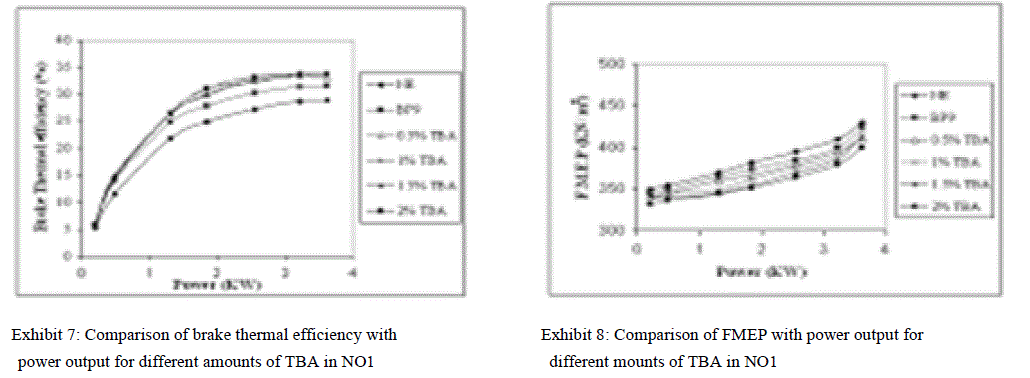 |
| The discrepancy of frictional mean effective pressure (FMEP) is illustrated in Exhibit 8 for different amounts of TBA in NO1. Among all with 2% of TBA the frictional loss are lowest and is 19 kN/m2 over BP9. 3. Effect of Teflon based Additive in NO2 The exhibit 9 exemplifies the variation of the thermal efficiency in the NO2 oil. The addition of 1.5% TBA to NO2 gives more efficiency and is about 8.3% to BP9 without any additive. For the 2% TBA the drop is less than 1.5% additive. The FMEP variation with TBA to the NO2 is exposed in exhibit 10. Frictional losses are low for 1.5% of TBA and are more with 2% of T.B.A compared to BP9. |
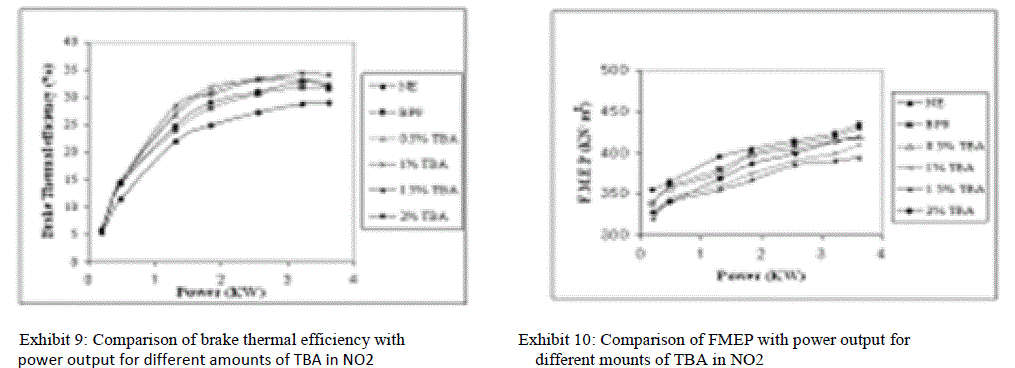 |
| 4. Effect of TBA in NO3 For the different amounts of TBA in NO3, the disparity of thermal efficiency is revealed in Exhibit 11. The N03 without additive is giving higher thermal efficiency. As the base oil itself is thick the blending of TBA doesn’t have any effect. |
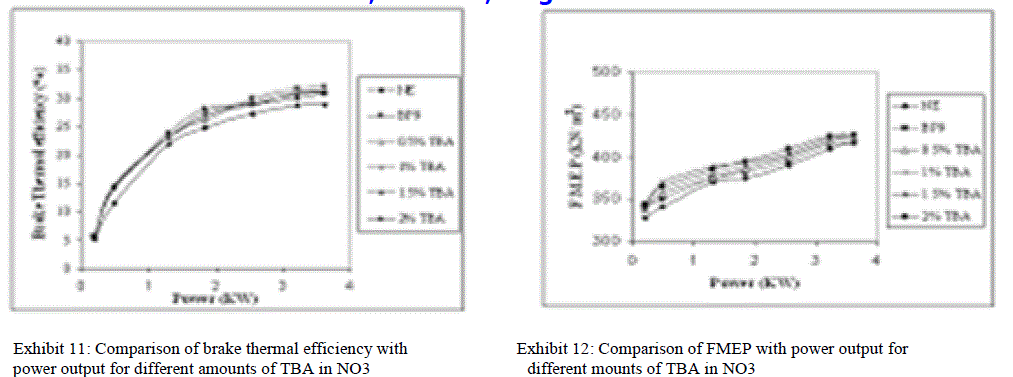 |
| The oil performance declines with the addition of higher amounts of TBA. Similarly the NO3 oil gives the lowest frictional losses and is evident from exhibit 12. |
III CONCLUSIONS |
| Based on the above experiments the following conclusions can be drawn |
| With the higher temperatures in the combustion chamber, the drop in volumetric efficiency with BP9 is 1.2% more than brass piston in the insulated engine and will be compensated with turbocharging |
| At the boost up pressure of 790 mm of Hg with turbocharging the drop in volumetric efficiency is compensated. |
| The commercially available lubricants are inadequate to perform under escalated temperatures. So new lubricants such as NO1, NO2 and NO3 have been developed and blended with different proportions of Teflon based additive. |
| Among the three new oils tested, the NO2 oil has shown the best performance. |
| Frictional losses are lowest for NO2 oil with 1.5% Teflon based additive and is about14 kN/m2 compared to the insulated engine |
| The brake thermal efficiency is increased by 8.3% for NO2 oil with 1.5% TBA compared to BP9. |
| All the above investigations are fruit full for the development of turbocharged insulated engine with NO2 lubricating oil with TBA. |
References |
|